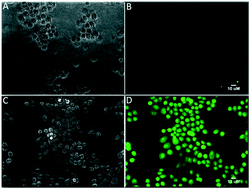当前位置:
X-MOL 学术
›
RSC Med. Chem.
›
论文详情
Our official English website, www.x-mol.net, welcomes your
feedback! (Note: you will need to create a separate account there.)
Live-cell fluorescence imaging: assessment of thioflavin T uptake in human epidermal carcinoma cells
RSC Medicinal Chemistry ( IF 4.1 ) Pub Date : 2018-04-20 00:00:00 , DOI: 10.1039/c8md00101d G S M Sundaram 1 , Kristen Binz 1 , Vedica Sharma 1 , Melany Yeung 2 , Vijay Sharma 1, 2, 3, 4
RSC Medicinal Chemistry ( IF 4.1 ) Pub Date : 2018-04-20 00:00:00 , DOI: 10.1039/c8md00101d G S M Sundaram 1 , Kristen Binz 1 , Vedica Sharma 1 , Melany Yeung 2 , Vijay Sharma 1, 2, 3, 4
Affiliation

|
Thioflavin T (ThT), a positively charged heterocyclic small molecule, is a widely used fluorescent marker of amyloid pathophysiology to confirm the cause of death in post mortem brain tissue of Alzheimer's disease (AD) patients. Literature precedents indicate that current positron emission tomography (PET) agents, such as 11C-PIB and 18F-flutemetamol, share significant structural similarity with ThT, a lipophilic dye which does not traverse the blood–brain barrier (BBB) to enable the detection of Aβ plaques in vivo. While vital for maintaining normal physiology and healthy brain function, the BBB comprises brain endothelial cells sealed via paracellular protein complexes, bound by an extracellular matrix forming tight junctions thus controlling the delivery of molecules into the brain. The human P-glycoprotein (Pgp/ABCB1, 170 kD plasma membrane protein), belonging to the ABC family of efflux transporter proteins, also lines the luminal surface of brain endothelial cells thus poised to secrete its recognized substrates into the blood. Herein, we postulate that thioflavin T (ThT), due to its physico-chemical attributes, such as moderate lipophilicity and protonated nitrogen, could very well be recognized as a transport substrate of Pgp (P-glycoprotein, ABCB1) thus restricting its permeation into the brain. To evaluate whether or not ThT is indeed recognized by Pgp as its transport substrate thus limiting its BBB permeability, herein, we evaluate cellular accumulation profiles of ThT and PiB (a similar structural uncharged mimetic) in human epidermal carcinoma KB-3-1 (Pgp−) and MDR KB-8-5 (Pgp+) cells, using live-cell fluorescence imaging. While ThT penetrates KB-3-1 cells, it gets excluded from KB-8-5 cells, and also indicates LY335979-induced uptake in Pgp-expressing cells. Furthermore, the cellular uptake profiles of PiB are not impacted by the expression of Pgp under identical conditions. These data show that uptake profiles of ThT have been modified by the expression of Pgp in these cells, and are inversely proportional to the expression of the transporter protein located on the plasma membrane of these cells. Combined data demonstrate that ThT is efficiently recognized by Pgp as its transport substrate.
中文翻译:

活细胞荧光成像:评估人表皮癌细胞中硫黄素 T 的摄取
硫磺素 T (ThT) 是一种带正电荷的杂环小分子,是一种广泛使用的淀粉样蛋白病理生理学荧光标记物,用于确定阿尔茨海默病 (AD) 患者死后脑组织的死因。文献先例表明,当前的正电子发射断层扫描(PET)试剂,例如11 C-PIB 和18 F-氟替他莫,与 ThT 具有显着的结构相似性,ThT 是一种不穿过血脑屏障(BBB)的亲脂性染料,能够使体内Aβ斑块的检测。虽然血脑屏障对于维持正常生理和健康的大脑功能至关重要,但它由通过细胞旁蛋白复合物密封的脑内皮细胞组成,通过细胞外基质结合形成紧密连接,从而控制分子向大脑的输送。人类 P-糖蛋白(Pgp/ABCB1,170 kD 质膜蛋白)属于外排转运蛋白 ABC 家族,也排列在脑内皮细胞的管腔表面,从而准备将其识别的底物分泌到血液中。在此,我们假设硫黄素 T (ThT) 由于其物理化学属性,如中等亲脂性和质子化氮,很可能被识别为 Pgp (P-糖蛋白,ABCB1) 的转运底物,从而限制其渗透到大脑。为了评估 ThT 是否确实被 Pgp 识别为其转运底物,从而限制其 BBB 通透性,本文中,我们评估了人表皮癌 KB-3-1 (Pgp −) 和 MDR KB-8-5 (Pgp+) 细胞,使用活细胞荧光成像。虽然 ThT 穿透 KB-3-1 细胞,但它被排除在 KB-8-5 细胞之外,并且还表明 LY335979 在表达 Pgp 的细胞中诱导摄取。此外,在相同条件下,PiB 的细胞摄取曲线不受 Pgp 表达的影响。这些数据表明,ThT 的摄取谱已被这些细胞中 Pgp 的表达所改变,并且与位于这些细胞质膜上的转运蛋白的表达成反比。综合数据表明,ThT 被 Pgp 有效识别为其转运底物。
更新日期:2018-04-20
中文翻译:

活细胞荧光成像:评估人表皮癌细胞中硫黄素 T 的摄取
硫磺素 T (ThT) 是一种带正电荷的杂环小分子,是一种广泛使用的淀粉样蛋白病理生理学荧光标记物,用于确定阿尔茨海默病 (AD) 患者死后脑组织的死因。文献先例表明,当前的正电子发射断层扫描(PET)试剂,例如11 C-PIB 和18 F-氟替他莫,与 ThT 具有显着的结构相似性,ThT 是一种不穿过血脑屏障(BBB)的亲脂性染料,能够使体内Aβ斑块的检测。虽然血脑屏障对于维持正常生理和健康的大脑功能至关重要,但它由通过细胞旁蛋白复合物密封的脑内皮细胞组成,通过细胞外基质结合形成紧密连接,从而控制分子向大脑的输送。人类 P-糖蛋白(Pgp/ABCB1,170 kD 质膜蛋白)属于外排转运蛋白 ABC 家族,也排列在脑内皮细胞的管腔表面,从而准备将其识别的底物分泌到血液中。在此,我们假设硫黄素 T (ThT) 由于其物理化学属性,如中等亲脂性和质子化氮,很可能被识别为 Pgp (P-糖蛋白,ABCB1) 的转运底物,从而限制其渗透到大脑。为了评估 ThT 是否确实被 Pgp 识别为其转运底物,从而限制其 BBB 通透性,本文中,我们评估了人表皮癌 KB-3-1 (Pgp −) 和 MDR KB-8-5 (Pgp+) 细胞,使用活细胞荧光成像。虽然 ThT 穿透 KB-3-1 细胞,但它被排除在 KB-8-5 细胞之外,并且还表明 LY335979 在表达 Pgp 的细胞中诱导摄取。此外,在相同条件下,PiB 的细胞摄取曲线不受 Pgp 表达的影响。这些数据表明,ThT 的摄取谱已被这些细胞中 Pgp 的表达所改变,并且与位于这些细胞质膜上的转运蛋白的表达成反比。综合数据表明,ThT 被 Pgp 有效识别为其转运底物。











































 京公网安备 11010802027423号
京公网安备 11010802027423号